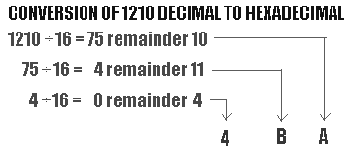Q. Show the Decimal to Hex Conversion?
To convert the decimal to the hex is slightly more difficult. The usual method to convert from decimal to hex is repeated division by 16. Whereas we may also use repeated subtraction by the weighted position value, it is more difficult for large decimal numbers.
For this process, divide the decimal number by 16, and write the remainder on the side as the least significant digit. This method is continued by dividing the quotient by 16 and writing the remainder until the quotient is 0. Whereas performing the division, the remainders which will represent the hex equivalent of the decimal number are written beginning at the least significant digit (right) and each new digit is written to the next more significant digit (the left) of the previous digit.
Consider the number 44978.
|
Division
|
Quotient
|
Remainder
|
Hex Number
|
|
44978 / 16
|
2811
|
2
|
2
|
|
2811 / 16
|
175
|
11
|
B2
|
|
175 / 16
|
10
|
15
|
FB2
|
|
10 / 16
|
0
|
10
|
0AFB2
|
Since you can see, we are back with the original number. That is what we should suppose.
When you use the hex numbers in an 8085 program, the Assembler usually requires the most significant hex digit to be 0 even if this number of digits exceeds the size of the register. This is an Assembler necessity and your value will be assembled correctly.
Illustration Convert the number 1,210 decimal to hexadecimal.

Consequently the decimal number 1,210 is equal to 4BAH in hexadecimal.